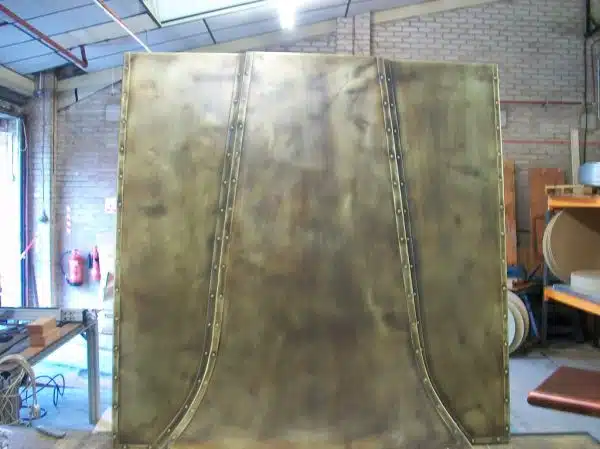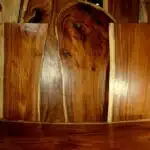Antique finishes on wood are a popular way to add character and charm to furniture, cabinets, and other wooden items. This finish can be achieved through various techniques, including using paint. By using paint, you can create an antique look on any wooden surface that will give it a unique and rustic appearance.
Achieving an antique finish with paint requires patience and attention to detail. It involves layering different colors of paint, sanding the surface in between coats, and adding distress marks to achieve an aged appearance. In this article, we will explore the step-by-step process of creating an antique finish with paint on wood. We will also provide tips and tricks to help you achieve the perfect vintage look that will make your furniture stand out. So if you’re ready to transform your plain wooden items into beautiful antiques, let’s get started!
Choosing The Right Type Of Wood For An Antique Finish
When it comes to achieving an antique finish on wood, the type of wood you choose can make all the difference. In order to create a vintage aesthetic, it’s important to select the right type of wood that can work well with paint and other finishing techniques. However, not all types of wood are suitable for an antique finish.
Firstly, avoid using softwoods such as pine or spruce as they tend to have a uniform texture which may not lend well to creating an aged look. Instead, opt for hardwoods such as oak or maple which have a more distinct texture and grain pattern that can be emphasized with paint. Additionally, avoid using woods with heavy knots as they can be difficult to work with when trying to achieve a smooth finish.
If your chosen piece of wood has knots, there are steps you can take to prepare them for painting. Start by sanding down the surface of the knot so that it is level with the rest of the wood. Then apply a knotting solution over the area to prevent any resin from bleeding through and ruining your finish. This will also help ensure a consistent appearance once you begin applying your paint and other finishing products.
With the right type of wood selected and any necessary preparations made for knots, you’re now ready to move onto preparing your wood surface for painting.
Preparing The Wood Surface For Painting
To achieve an antique finish on wood, it is essential to prepare the surface properly before painting. Wood surface cleaning is the first step in this process. You should remove any dirt, grease, or grime from the surface using a mild detergent and warm water. After cleaning, rinse the wood with clean water and let it dry completely.
Once the wood has dried completely, it’s time to prime it. Priming techniques vary depending on the type of wood you are working with and the finish you want to achieve. For an antique look, use a tinted primer that complements your chosen paint color. The primer will help seal the wood and provide a smooth surface for painting.
When priming is complete, allow it to dry for several hours before painting. Selecting the right paint colors for an antique look is crucial at this stage since not every color will create an antique finish. To achieve this effect, choose muted colors such as beige, ivory, gray, or pastel shades. These colors will complement each other well and give your furniture a charming vintage look that never goes out of style.
Transition: Now that we have prepared our wooden surface adequately and primed it correctly let us move onto selecting appropriate paint colors to give that furniture piece an antique appearance!
Selecting The Right Paint Colors For An Antique Look
When it comes to selecting the right paint colors to create an antique finish on wood, color selection is key. It is important to consider the color palette you are working with and understand how color theory contributes to the overall look of the piece. Choosing a muted, earthy palette will help to give the antique look more authenticity, while more vibrant colors can be used to create a more contemporary feel. Ultimately, the choice of colors should be based on the desired end result and the desired effect.
Choosing Colors
When it comes to achieving an antique finish on wood, choosing the right colors can make all the difference. A great place to start is by considering color palettes from different time periods. For example, if you’re going for a vintage Victorian look, you might want to choose muted jewel tones like deep reds and greens, or soft blues and pinks. Alternatively, if you’re aiming for a rustic farmhouse feel, earthy tones like browns and greens can be perfect.
Color coordination is also important in achieving an antique look. Once you’ve chosen your main color palette, think about adding accent colors that complement and enhance the overall effect. For example, if you’ve chosen a soft blue as your main color, consider using cream or beige as an accent color for a subtle contrast. Or if you’ve gone with a deep red, try pairing it with gold or brass accents for a more dramatic effect.
Remember that there are no hard and fast rules when it comes to selecting colors for an antique finish. Ultimately, the best way to achieve the look that you want is by experimenting with different color combinations until you find something that feels just right. With some patience and creativity, you’ll soon have a beautiful antique finish on your wood that will be sure to impress anyone who sees it!
Color Theory
Selecting the right paint colors for an antique look can be a daunting task, but it doesn’t have to be. One way to make the process easier is by understanding color theory. Color theory is the study of how colors interact with each other and how they can be combined to create different visual effects. By applying color theory principles to your paint choices, you can create a cohesive and authentic antique finish on wood.
When it comes to color combinations, there are two main options: complementary and analogous. Complementary colors are opposite each other on the color wheel, such as blue and orange or red and green. Using complementary colors in an antique finish can create a striking contrast effect that draws attention to certain features of the woodwork. On the other hand, analogous colors are next to each other on the color wheel, such as blue and green or red and orange. Analogous color combinations create a more subtle effect that blends together harmoniously.
Another important aspect of color theory is understanding how light affects color perception. Natural light will often bring out warmer tones in wood while artificial lighting may highlight cooler tones. Keep this in mind when selecting your paint colors so that you achieve the desired effect regardless of lighting conditions.
By using these principles of color theory and experimenting with different combinations, you can achieve a beautiful antique finish on your woodwork that will impress anyone who sees it. Whether you opt for bold complementary contrasts or subtle analogous blends, selecting the right paint colors is essential in creating an authentic vintage look for your home décor projects!
Mixing Paints To Achieve The Desired Hue
To achieve an antique finish on wood, it is essential to mix paints effectively to get the desired hue. Mixing techniques should be consistent and precise while combining colors. The hues used for the antique finish usually include earthy tones like brown, beige, or gray.
When mixing paint, it is best to start by adding small amounts of pigment to the base color and gradually building up the intensity of the shade until you reach your desired hue. If you want a lighter tone, add white paint to dilute it. On the other hand, if you need a darker shade, mix in black or another dark color sparingly. A general guideline is to use three colors for creating an antique finish.
An ideal color combination for an antique finish would be a mixture of gray-brown with beige and cream. These hues blend well together and create a natural-looking patina effect that resembles aged wood. Experiment with different combinations before settling on one that works best for your project. Once you have achieved your desired hue, move on to applying the first coat of paint without delay.
Applying The First Coat Of Paint
- When selecting paint for an antique finish on wood, it is important to consider both the type and colour of paint.
- Before applying the paint, the wood should be thoroughly cleaned and sanded to ensure a smooth surface.
- For a successful antique finish, it is best to use a primer or base coat of paint before applying the colour coat.
- To ensure good coverage, the paint should be applied using a brush, roller or spray gun.
- Before applying the second coat, the first coat should be allowed to dry completely.
- To give the antique finish a unique look, a glaze can be added over the paint once it has dried.
Choosing Paint
When it comes to creating an antique finish on wood, choosing the right paint is a crucial step. Color schemes and brush techniques play a significant role in achieving the desired effect. For instance, if you’re looking for a distressed finish, consider using muted tones such as cream or gray. On the other hand, if you want a more vibrant look, opt for brighter colors like teal or turquoise.
When selecting paint for an antique finish, it’s essential to keep in mind that different types of paint will provide varying results. For instance, chalk paint is ideal for creating a vintage look because of its matte finish and ability to easily distress with sandpaper. Milk paint also works well for this purpose due to its crackling effect when applied over bare wood surfaces.
Brush techniques are equally important when applying the first coat of paint. To achieve an authentic antique look, use a dry brush technique by lightly brushing the surface with just enough paint to create texture and allow the natural wood grain to show through. This method adds depth and character to your piece while giving it that coveted aged appearance.
In summary, choosing the right color scheme and understanding different paint types and brush techniques are critical elements in creating an antique finish on wood. By taking these factors into account during the first coat application process, you can successfully achieve your desired result.
Preparing The Wood
Before applying the first coat of paint, it’s crucial to prepare the wood properly. One of the most important decisions is whether to stain or sand your piece. Staining can add depth and richness to the wood grain, while sanding creates a smooth surface for paint application. Additionally, you’ll need to consider if your wood is natural or treated. If it’s treated, you may need to use a deglosser or sander to remove any existing finish before painting.
If you choose to sand your piece, start with a coarse grit sandpaper and gradually work up to a finer grit for a smoother result. It’s essential to remove all dust and debris before proceeding with painting. Alternatively, if you opt for staining, make sure that the surface is clean and dry before applying the stain evenly with a brush or cloth.
Once you’ve finished preparing your wood, it’s time to apply the first coat of paint. As mentioned earlier, brush techniques play an important role in achieving an authentic antique look. Using a dry brush technique allows the natural wood grain to show through while adding texture and depth. Be mindful not to overload your brush with too much paint; this can lead to drips and uneven coverage. Apply thin coats of paint in one direction and allow each layer to dry completely before adding another coat.
Applying The Paint
Now that you have prepared your wood, it’s time to move on to the exciting part of the process – applying the first coat of paint. The key to achieving an authentic antique look is to use blending techniques and stenciling methods. These techniques add depth and texture to the surface while creating a unique and personalized finish.
When applying paint, it’s essential to choose the right brush for your project. A flat brush works well for large surfaces, while a round brush is ideal for intricate details. Remember not to overload your brush with too much paint; this can lead to drips and uneven coverage. Apply thin coats of paint in one direction, allowing each layer to dry completely before adding another coat.
Blending techniques involve overlapping two or more colors of paint to create a subtle transition between them. Start by applying a base coat of paint and then lightly brushing on a second color in long strokes. Blend the two colors together by gently dragging a dry brush over the surface in a circular motion. Stenciling methods involve using pre-cut stencils or creating your own design with masking tape. Apply paint over the stencil using a stippling motion, being careful not to overload your brush with too much paint. With patience and practice, you can achieve stunning results!
Sanding The Surface For A Distressed Look
Once the first coat of paint has dried, it’s time to move on to sanding the surface for a distressed look. This step is crucial in achieving an antique finish on wood. Using sandpaper effectively is key, and it’s important to choose the right grit for the job. A medium-grit sandpaper is usually best for this step.
Begin by lightly sanding the surface of the painted wood. Sand any areas where natural wear and tear would occur over time, such as corners and edges. Don’t be afraid to apply some pressure when sanding – this will create more texture and help achieve a more authentic, aged appearance. Remember to wipe away any dust or debris before moving onto distressing techniques for wood surfaces.
Distressing techniques can vary depending on personal preference, but there are a few common methods that work well. One technique involves using a hammer or screwdriver to add small dents and scratches to the surface of the wood. Another method is to use a chisel or knife to create intentional marks that resemble cracks or chips. These techniques can help give your piece an authentic appearance that looks like it’s been around for years.
Transition: Now that you’ve mastered sanding and distressing techniques, it’s time to take things one step further by adding cracks and chips for an even more authentic appearance.
Adding Cracks And Chips For An Authentic Appearance
When it comes to creating an antique finish on wood, adding cracks and chips is a crucial step for achieving an authentic appearance. This technique involves creating texture on the surface of the wood to simulate years of wear and tear. But how can you do this effectively and efficiently? Let’s take a closer look.
The first step in adding cracks and chips is choosing the right tools. You’ll need sandpaper, a putty knife, and some wood filler. Start by sanding down the surface of the wood to remove any rough patches or blemishes. Then, use the putty knife to apply the wood filler to any areas that you want to appear cracked or chipped. Once it dries, use the sandpaper again to smooth out any excess.
Creating texture is all about being creative and experimenting with different techniques. One method is to use a wire brush or nail to scrape along the surface of the wood in long strokes. Another option is to use a hammer or mallet to create small dents and divots in strategic areas. The key is to be patient and take your time until you achieve the desired effect. By following these tips, you’ll be well on your way to creating an antique finish that will impress even the most discerning eye.
As you move on from adding cracks and chips, it’s important not to forget about applying a second coat of paint. This step will help seal in all of your hard work and give your piece a beautiful finished look. In the next section, we’ll explore some tips for making sure that your second coat goes on smoothly and evenly – so stay tuned!
Applying A Second Coat Of Paint
- Sanding is a crucial part of the process when applying a second coat of paint to wood, as it helps to create an even finish.
- Priming is also recommended before applying a second coat of paint, as it creates a barrier between the wood and the paint, and helps to ensure a smoother finish.
- Finishing off with a polyurethane sealant can contribute to the longevity of the painted surface, and help to protect it from scratches and wear.
- Care should be taken to ensure that all surfaces are sanded properly before applying a second coat of paint, in order to create a uniform finish.
- Priming should be applied in thin layers, in order to reduce the risk of bubbling or pooling.
- Once the second coat of paint has been applied, a light sanding is recommended to ensure a smooth, professional finish.
Sanding
Sanding is a crucial step in achieving an antique finish on wood. Using different sanding techniques can help you achieve the desired texture and look. For instance, distressing the wood with sandpaper or using a wire brush to create a worn-out effect can add character to your furniture piece.
Choosing the right sandpaper grit is equally important. For the first round of sanding, use a coarse grit like 80 or 100 to remove any paint drips or imperfections on the surface. After applying the second coat of paint, use a finer grit like 220 to smooth out the surface and prepare it for further distressing.
Remember not to over-sand as it can damage your furniture’s natural grain patterns. Always sand in the direction of the wood grain and avoid circular motions that can leave unsightly marks. With these sanding tips, you’ll be able to create an authentic antique finish that looks like it’s been passed down through generations effortlessly.
Priming
After sanding your furniture, the next step in achieving an antique finish is to prime it before applying a second coat of paint. Primers are essential because they help the paint adhere better to the surface and prevent it from chipping or peeling off over time. There are different types of primers you can use depending on the type of paint you’re using and the condition of your furniture.
Before applying primer, make sure to sand the surface again with a fine grit sandpaper like 220 to remove any leftover dust or debris from the previous sanding. This ensures that the primer adheres well to the surface and creates a smooth base for the paint. Sanding before priming is crucial because it helps remove any imperfections on the surface and allows the primer to bond properly with the wood.
When choosing a primer, consider factors such as whether you’re painting over bare wood or previously painted surfaces, whether you’re using oil-based or water-based paint, and whether you need a stain-blocking primer for surfaces with stains or discoloration. Applying a primer may seem like an extra step, but it can save you time and money in the long run by ensuring that your paint job lasts longer and looks more professional. So don’t skip this important step if you want to achieve an authentic antique finish on your furniture piece!
Finishing
After priming your furniture, the next step in achieving an antique finish is to apply a second coat of paint. Choosing the right type of paint is crucial in achieving the desired look. For an authentic vintage finish, it’s best to use a chalk paint or milk paint as they have a matte finish and can be distressed easily. These types of paint also work well with different distressing techniques such as sanding, rubbing, and waxing.
Experimenting with different distressing techniques can create unique and interesting effects on your furniture piece. Sanding along edges and corners can create a worn and aged look, while rubbing with steel wool can give a subtle rustic feel. Waxing your piece after painting can add depth and dimension to your finish. It’s important to note that distressing should be done carefully and strategically to achieve an intentional rather than haphazard look.
After applying the second coat of paint and distressing as desired, it’s time to finish off your piece with a protective topcoat. A clear wax or polyurethane can seal in the color and protect your furniture from wear and tear for years to come. Applying these products may require multiple coats depending on the level of protection you desire. With these finishing touches, you’ll have transformed your furniture into a one-of-a-kind antique masterpiece!
Using A Dry Brush Technique For A Faded Look
After applying a second coat of paint, you may be looking to add some character and depth to your wooden piece. One way to achieve an antique finish is by utilizing the dry brush technique. This technique involves using a dry brush with very little paint on it to lightly sweep over the surface of the wood, creating a faded and distressed appearance.
There are both pros and cons to using the dry brush technique. On one hand, it allows for more control over the amount of paint being applied, resulting in a subtle and natural-looking finish. It also adds texture and dimension to flat surfaces, giving them a more interesting and unique appearance. However, it can be time-consuming and requires patience to achieve the desired effect. Additionally, it may not work well on rough or heavily textured surfaces.
To ensure a perfect finish with the dry brush technique, there are some tips and tricks that can be helpful. Firstly, make sure that your brush is completely dry before starting. This will prevent any excess water from diluting the paint and causing streaks or smudges. Secondly, practice on a test surface before applying it to your final piece. This will allow you to experiment with different techniques and find what works best for you.
Incorporating painting details into your antique finish can give your piece a customized look that truly makes it stand out. From adding highlights to intricate carvings or accents around edges, taking the time to focus on these small details can take your finished product from good to great. With these techniques in mind, you can create an antique finish that adds character and charm to any wooden piece in your home.
Painting The Details For A Customized Finish
Creating an antique finish on wood requires attention to detail and customized detailing. Antique paint techniques are a great way to achieve this look, but the process can be challenging for beginners. However, with the right tools and a little patience, anyone can create a stunning antique finish on their wooden furniture.
To begin, start by painting the details of your piece with a small brush and your chosen color of paint. This is where customized detailing comes in – you can choose to paint certain areas or patterns to give your furniture a unique touch. Be sure to let the paint dry completely before moving onto the next step.
Once the details have been painted, it’s time to apply the antique finish. Using a dry brush technique, lightly drag your brush over the surface of the painted areas with a darker shade of paint. This will create depth and texture that mimics the natural wear and tear of an antique piece. Continue until you achieve your desired level of antiquing. With these simple steps, you can transform any piece of wooden furniture into a beautiful antique masterpiece.
Now that your antique finish is complete, it’s important to protect it by applying a protective finish to seal the paint. This will prevent any damage or fading from occurring over time. There are many options for protective finishes such as wax or polyurethane – choose one that works best for your specific project needs. With these final steps, you can enjoy your newly transformed antique piece for years to come.
Applying A Protective Finish To Seal The Paint
Now that you have successfully applied paint to your wooden piece and created an antique finish, it is essential to apply a protective finish to seal the paint. This will not only preserve the beauty of your work but also protect the wood from damage caused by moisture, UV rays, and scratches.
The best sealants for painted wooden surfaces are oil-based polyurethane, water-based polyurethane, and wax. Oil-based polyurethane provides a durable finish that enhances the wood grain’s natural beauty. Water-based polyurethane is easy to apply and dries quickly, making it an ideal choice for beginners. Wax provides a low-luster finish that gives antique furniture its distinctive look.
One of the most common mistakes people make when applying a protective finish is failing to sand between coats. Sanding helps to remove any imperfections on the surface and create a smooth texture for subsequent coats. Another mistake is not allowing enough drying time between coats, which can cause the previous layer to peel or crack. To avoid these issues, follow the manufacturer’s instructions carefully and allow each coat to dry completely before applying another one.
To ensure a flawless finish, buff the surface with fine-grit sandpaper after applying the final coat of sealant. This will remove any bumps or imperfections on the surface and give it a smooth texture that feels great to touch. Buffing also helps bring out the shine in wax finishes, giving your piece that authentic antique look you desire. With these simple steps, you can create a beautiful antique finish on any wooden piece that will last for years to come.
Buffing The Surface For A Smooth Texture
- Sanding is the first step in creating an antique finish on wood, and is necessary for smoothing out the surface.
- Polishing, waxing, and buffing are then used to create a smooth texture on the wood.
- Various pads, cloths, machines, oils, primers, sealers, and finishes such as lacquers, shellacs, varnishes, and stains can be used to create an antique wood finish.
- It is important to use the correct materials and techniques to ensure a high quality and long lasting finish.
Sanding
Distressing wood to create an antique finish is a satisfying and rewarding task. However, before you can apply paint, buffing the surface for a smooth texture is essential. Using sandpaper is the first step in this process.
When sanding, it’s important to choose the right grit. Start with a coarse grit to remove any roughness or bumps on the surface. Then use progressively finer grits until you achieve the desired smoothness. Be sure to sand in the direction of the grain to avoid creating scratches that will show through once painted.
Don’t be afraid to put some elbow grease into it! Sanding takes time and effort, but it’s worth it for a flawless finish. Once you’re done, wipe down the surface with a damp cloth to remove any dust or debris before moving on to the next step in your antique finishing process.
Polishing
To achieve a smooth and flawless finish, buffing the surface after sanding is the next step in your antique finishing process. The benefits of polishing are numerous, including removing any remaining scratches or imperfections, enhancing the shine and luster of the wood, and creating a protective layer that helps to prevent damage from moisture or other environmental factors.
There are different types of polishing techniques you can use, depending on the type of wood and finish you’re working with. One popular option is using a buffing wheel with a polishing compound to create a high-gloss shine. Another technique involves using wax or oil-based polishes to create a more natural-looking finish that also enhances the color and texture of the wood.
Before applying any polish, ensure that your surface is clean and free of any dust or debris left over from sanding. It’s important to follow instructions carefully when using polishing compounds or other products, as they can be abrasive and potentially damaging if used improperly. A little bit of patience and attention to detail will go a long way in achieving the perfect antique finish for your project.
Adding A Glaze For A More Aged Appearance
Imagine your wooden furniture with a warm, antique glow. You can achieve this look by incorporating a glaze into the painting process. Using contrasting colors, such as dark brown and cream, you can create depth in the glaze that mimics the natural aging process of wood.
To begin, mix your chosen paint color with a glazing medium in a 4:1 ratio. Apply a thin layer of the glaze onto the painted surface using a brush or rag. Immediately after applying the glaze, wipe it off with a clean rag to remove any excess and reveal the underlying color. Repeat this process until you achieve your desired level of aging.
For added depth and texture, experiment with layering techniques using different colors of glaze. This will create a more realistic-looking antique finish on your wooden furniture. Don’t be afraid to try out different finishes, such as satin or matte, to see which one enhances the antique look best for your project.
Using Wax To Enhance The Antique Look
Now that you have added a glaze to your wood piece, it’s time to take it one step further by using wax to enhance the antique look. Using wax is an excellent way to add depth and character to your furniture, and it can also help protect the surface from scratches and wear over time.
To start, you will need a soft-bristled brush or rag and a can of high-quality furniture wax. Apply a thin layer of wax all over the surface of your piece, making sure to work it into any crevices or details. Allow the wax to dry for at least 10-15 minutes before buffing it with a clean cloth until you achieve the desired level of shine.
If you want to achieve an even more distressed look, consider using some distressing techniques before applying the wax. This could include sanding down some areas of the wood or hitting it with a chain or hammer in strategic places. The key is to create natural-looking wear and tear that adds to the overall aesthetic of your piece.
Tips for Using Wax:
- Use a soft-bristled brush or rag when applying wax
- Apply a thin layer all over the surface
- Work wax into any crevices or details
Distressing Techniques:
- Sanding down some areas of the wood
- Hitting it with a chain or hammer in strategic places
- Creating natural-looking wear and tear
Benefits of Using Wax:
- Adds depth and character
- Protects against scratches and wear over time
- Enhances overall aesthetic
With these tips in mind, you should be well on your way to creating an antique finish on wood that will impress everyone who sees it. In our next section, we’ll discuss displaying and caring for your newly finished antique piece so that you can enjoy its beauty for years to come.
Displaying And Caring For Your Newly Finished Antique Piece
Caring tips are essential to ensure that your newly finished antique piece remains in pristine condition for years to come. The first and most important step is to keep it clean. Dust and other particles can quickly accumulate on the surface of the wood, causing it to deteriorate over time. Use a soft cloth or feather duster to gently remove any dust or debris from the surface.
Another important aspect of caring for your antique piece is to avoid exposing it to direct sunlight or extreme temperatures. Prolonged exposure to these elements can cause the wood to fade or warp, which will diminish its value and beauty. It’s best to keep your piece in a cool, dry place away from windows and direct sunlight.
When it comes to displaying your newly finished antique piece, there are many creative ideas you can explore. One option is to use it as a centerpiece on a dining table or as an accent piece in a living room. You could also display it in a glass cabinet or on a shelf with other vintage items that complement its style and design. Whatever display option you choose, make sure it highlights the unique features of your antique piece and helps it stand out as a focal point in the room.
In summary, caring for your newly finished antique piece requires attention and diligence. By keeping it clean and avoiding exposure to direct sunlight or extreme temperatures, you can help preserve its beauty and value for years to come. When displaying your antique piece, be creative and choose an option that showcases its unique features while complementing your overall decor style. With proper care and attention, your antique treasure will continue to shine for generations to come!
Conclusion
After following these steps, you will have successfully created an antique finish on your wood. However, it is important to note that the success of this process relies heavily on the quality of wood and paint used. It is recommended to use high-quality materials to achieve the best results.
One theory surrounding antique finishes suggests that they add character and value to a piece of furniture or decor. While this may be true in some cases, it ultimately depends on personal preference and the specific item in question. What cannot be denied, however, is the beauty and charm that an antique finish can bring to a piece.
As a DIY paint finishing expert, it is important to approach each project with care and attention to detail. With patience and practice, anyone can master the art of creating an antique finish on wood. So go ahead – experiment with different colors, techniques, and finishes to create unique and beautiful pieces for your home or business.
Image Credits
- “17 – Brass Chimmeny Hood Antiqued Finish” by Metal Sheets Limited (featured)





























